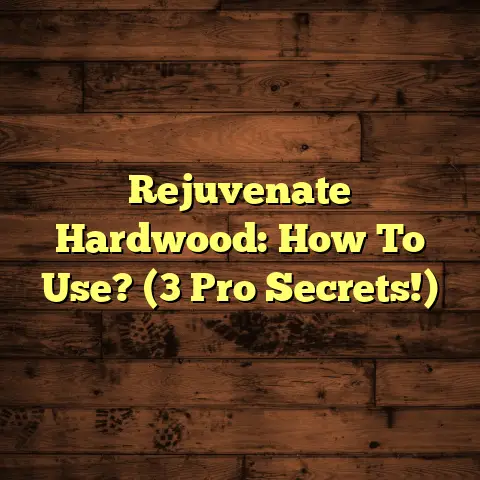Squeaky Laminate on Concrete? Easy Fixes (2 Solutions!)
Easy Fixes (2 Solutions!)
Laminate flooring: it’s the chameleon of the flooring world!
It’s become super popular because it’s affordable and looks great.
You can get it to mimic hardwood, tile, or even stone.
This makes it an awesome choice for almost any design style.
But here’s the thing: have you ever dealt with a squeaky floor, especially laminate laid over concrete?
Ugh, it’s the worst!
Don’t worry, though. I’ve been there, seen that, fixed that.
And I’m here to tell you that those annoying squeaks are usually pretty easy to tackle with the right know-how.
Let’s dive into some simple fixes to get your floor peaceful and quiet again.
Section 1: Understanding the Causes
of Squeaky Laminate
Subsection 1.1: The Anatomy of Laminate Flooring
Okay, so what exactly is laminate flooring?
Think of it like a layered cake.
You’ve got a wear layer on top – that’s the tough guy that protects against scratches and stains.
Below that is a decorative layer, the pretty picture that makes it look like wood or stone.
Then comes the core board, usually made of high-density fiberboard (HDF) or medium-density fiberboard (MDF).
This is the thickest part and gives the floor its structure.
Finally, there’s a backing layer, which provides stability and moisture resistance.
Now, when this “cake” sits on concrete, things can get interesting.
Concrete is hard and, let’s face it, not always perfectly level.
Plus, it can hold moisture.
This is where things can go wrong and lead to those annoying squeaks.
Subsection 1.2: Common Causes of Squeaking
So, why does laminate squeak when it’s on concrete? There are a few usual suspects:
-
Inadequate Underlayment: This is a big one. Underlayment is that foam or cork layer you put between the concrete and the laminate. It acts as a cushion, sound barrier, and moisture barrier. If it’s too thin, cheap, or missing altogether, you’re asking for squeaks.
-
Moisture Issues: Concrete can wick up moisture from the ground. If that moisture gets trapped under the laminate, it can cause the laminate to expand and contract, leading to squeaks.
-
Improper Installation: Did you leave enough space around the edges of the room for expansion? If the laminate is too tightly fitted, it can rub against itself or the walls, causing squeaks. Also, uneven concrete can create high spots where the laminate rubs and squeaks.
-
Debris: Sometimes, it’s as simple as small bits of dirt or debris trapped under the laminate. These can act like tiny pebbles, causing friction and noise when you walk on the floor.
-
Cheap Laminate: Let’s be real, some laminates are just better than others. Cheaper laminates might have thinner core boards or less precise locking systems, making them more prone to squeaking.
Subsection 1.3: The Impact of Temperature and Humidity
Think of your laminate floor like a living thing—it reacts to its environment.
Temperature and humidity changes can cause it to expand and contract.
In the winter, when it’s cold and dry, the laminate might shrink slightly.
In the summer, when it’s hot and humid, it might expand.
I’ve seen cases where a floor is perfectly quiet in the summer, but then starts squeaking like crazy in the winter.
It’s all about that expansion and contraction!
Example: I once worked on a project in Denver, Colorado, where the humidity swings are huge.
The client swore the floor wasn’t squeaking when it was installed in July, but by December, it sounded like a haunted house.
We ended up having to add more expansion space around the perimeter and lubricate the joints to solve the problem.
Section 2: Solution 1 – Using an Appropriate
Underlayment
Subsection 2.1: Importance of Underlayment
Let’s talk underlayment.
Seriously, this stuff is a lifesaver.
It’s not just some optional extra; it’s a crucial part of a successful laminate installation, especially over concrete.
Here’s why:
-
Sound Absorption: Underlayment acts like a sponge, soaking up the sound of footsteps and reducing noise. This is especially important in apartments or multi-story homes.
-
Moisture Barrier: Concrete can be porous and allow moisture to seep through. Underlayment helps to block that moisture, protecting the laminate from warping and swelling.
-
Cushioning: It provides a layer of cushioning under the laminate, making it more comfortable to walk on.
-
Leveling: It can help to smooth out minor imperfections in the concrete subfloor, creating a more even surface for the laminate. Note: I’m talking minor imperfections here. If your concrete is seriously uneven, you’ll need to address that separately.
-
Squeak Prevention: Most importantly for our purposes, it helps to prevent squeaks by reducing friction between the laminate and the concrete.
Subsection 2.2: Choosing the Right Underlayment
Not all underlayments are created equal.
For concrete floors, you need to be especially careful to choose the right type. Here are a few options:
-
Foam Underlayment: This is the most common and affordable type. It’s lightweight, easy to install, and provides decent sound absorption and cushioning.
- Pros: Affordable, easy to install
- Cons: Can compress over time, may not be the best for moisture protection
-
Cork Underlayment: Cork is a natural, sustainable material that offers excellent sound absorption and insulation. It’s also naturally resistant to mold and mildew.
- Pros: Excellent sound absorption, eco-friendly, moisture resistant
- Cons: More expensive than foam, can be more difficult to install
-
Rubber Underlayment: This is the most expensive option, but it offers the best performance. It’s incredibly durable, provides excellent sound absorption, and is highly resistant to moisture.
- Pros: Superior sound absorption, durable, excellent moisture protection
- Cons: Most expensive, can be heavy
Important Considerations:
-
Thickness: For concrete, I usually recommend at least a 3mm underlayment, but thicker is often better.
-
Moisture Barrier: Make sure the underlayment has a built-in moisture barrier, or that you install a separate vapor barrier underneath it.
-
Manufacturer’s Recommendations: Always follow the laminate flooring manufacturer’s recommendations for underlayment. Using the wrong underlayment can void your warranty.
Here’s a quick table to summarize the options:
| Underlayment Type | Pros | Cons | Best For |
|---|---|---|---|
| Foam | Affordable, easy to install | Can compress, not best for moisture | Budget-conscious projects, general use |
| Cork | Excellent sound absorption, eco-friendly, moisture resistant | More expensive, can be harder to install | Soundproofing, eco-friendly homes, moisture-prone areas |
| Rubber | Superior sound absorption, durable, moisture protection | Most expensive, can be heavy | High-end projects, demanding soundproofing, maximum protection |
Subsection 2.3: Installation Process
Alright, let’s get down to business.
Here’s how to install underlayment correctly:
-
Prepare the Concrete: Make sure the concrete is clean, dry, and level. Sweep, vacuum, and scrape away any debris. If there are any major cracks or uneven spots, fill them in with a concrete patching compound. Let it dry completely. Tip: Use a self-leveling compound for best results if the floor is significantly uneven.
-
Install a Vapor Barrier (If Needed): If your underlayment doesn’t have a built-in moisture barrier, install a separate vapor barrier over the concrete. Overlap the seams by at least 6 inches and tape them together with moisture-resistant tape.
-
Roll Out the Underlayment: Start in one corner of the room and roll out the underlayment, following the manufacturer’s instructions. Most underlayments are designed to be installed perpendicular to the direction of the laminate flooring.
-
Trim to Fit: Use a utility knife to trim the underlayment to fit around walls, pipes, and other obstacles. Leave a small gap (about 1/4 inch) around the perimeter of the room for expansion.
-
Tape the Seams: Use the manufacturer’s recommended tape to seal the seams between the underlayment rolls. This will help to prevent moisture from seeping through.
-
Inspect and Correct: Before installing the laminate, inspect the underlayment for any gaps, tears, or imperfections. Repair or replace as needed.
Key Tips for a Squeak-Free Installation:
-
Don’t Skip the Vapor Barrier: Seriously, don’t. Moisture is the enemy of a quiet floor.
-
Overlap and Tape Seams Thoroughly: This is where moisture can sneak in.
-
Use the Right Tape: Don’t just grab any old tape. Use moisture-resistant tape that’s designed for this purpose.
-
Cut Carefully: Precise cuts are essential for a snug fit and to avoid gaps that can lead to squeaks.
Subsection 2.4: Testing for Squeaks
Okay, you’ve installed the underlayment.
Now, before you lay down the laminate, let’s do a squeak test.
Walk all over the underlayment, paying close attention to any areas that seem to be making noise.
If you hear any squeaks, investigate the cause.
It could be a gap in the underlayment, a piece of debris underneath, or an uneven spot in the concrete.
Correct the problem before moving on to the laminate.
Tip: Sometimes, a squeak can be hard to pinpoint. Try having someone else walk on the underlayment while you listen closely from below (if possible).
If you find a squeak:
-
Lift the Underlayment: Carefully lift the underlayment in the area where you heard the squeak.
-
Inspect the Concrete: Look for any debris, cracks, or uneven spots.
-
Correct the Problem: Remove any debris, fill in cracks with patching compound, or smooth out uneven spots with a scraper.
-
Reinstall the Underlayment: Carefully reinstall the underlayment, making sure it’s snug and secure.
-
Test Again: Walk over the area again to see if the squeak is gone.
Remember: It’s much easier to fix squeaks at this stage than it is after the laminate is installed.
Take your time, be thorough, and get it right.
Section 3: Solution 2 – Lubricating the Floor
Subsection 3.1: When to Use Lubrication
Okay, so you’ve got a good underlayment installed, but you’re still hearing squeaks.
Frustrating, right?
Don’t despair!
Sometimes, even with the best underlayment, laminate planks can rub against each other and cause squeaks.
This is where lubrication comes in.
Think of it like WD-40 for your floor.
Lubrication is especially effective in these situations:
-
Click-Lock Laminate: These types of laminate floors rely on a tongue-and-groove system to lock together. Over time, the joints can become dry and start to squeak.
-
Areas with High Traffic: Areas where you walk frequently are more prone to squeaking due to increased friction.
-
Seasonal Squeaks: As mentioned earlier, changes in temperature and humidity can cause the laminate to expand and contract, leading to squeaks. Lubrication can help to ease this movement.
-
Spot Squeaks: If you have just a few isolated squeaks, lubrication can be a quick and easy fix.
-
Existing Floors: You don’t have to tear up your entire floor to lubricate it. This is a great option for addressing squeaks in existing laminate floors.
Subsection 3.2: Types of Lubricants
So, what can you use to lubricate your squeaky floor? Here are a few options:
-
Talcum Powder: This is a classic choice. It’s cheap, readily available, and works well for filling in small gaps and reducing friction.
- Pros: Affordable, easy to find
- Cons: Can be messy, may not last long
-
Graphite Powder: This is a dry lubricant that’s often used for locks and hinges. It’s very effective at reducing friction and is less messy than talcum powder.
- Pros: Very effective lubricant, less messy than talcum powder
- Cons: Can be more difficult to find, can stain if not applied carefully
-
Silicone Spray: This is a synthetic lubricant that’s designed to reduce friction and protect against moisture. It’s a good option for areas that are prone to dampness.
- Pros: Reduces friction, protects against moisture
- Cons: Can be slippery if over-applied, may contain chemicals
-
Specially Formulated Laminate Floor Lubricants: Some manufacturers make lubricants specifically for laminate floors. These are usually the safest and most effective option, but they can be more expensive.
- Pros: Designed specifically for laminate, safe and effective
- Cons: Can be more expensive
Important Considerations:
-
Avoid Oil-Based Lubricants: Oil can damage laminate flooring and attract dirt.
-
Test in an Inconspicuous Area: Before applying any lubricant to your entire floor, test it in a hidden area to make sure it doesn’t stain or damage the finish.
Subsection 3.3: Application Techniques
Alright, let’s get lubricating!
Here’s how to apply lubricants to minimize squeaks:
-
Locate the Squeaky Areas: Walk around the floor and identify the exact spots where the squeaks are coming from. Mark these areas with painter’s tape.
-
Clean the Area: Use a damp cloth to clean the area around the squeak. Make sure it’s dry before applying the lubricant.
-
Apply the Lubricant:
-
Talcum Powder or Graphite Powder: Sprinkle a small amount of powder over the squeaky area. Use a soft brush or cloth to work the powder into the seams between the planks.
-
Silicone Spray: Spray a small amount of silicone spray into the seams between the planks. Be careful not to over-apply.
-
Specially Formulated Lubricants: Follow the manufacturer’s instructions for application.
-
-
Wipe Away Excess: Use a clean, dry cloth to wipe away any excess lubricant from the surface of the floor.
-
Test the Area: Walk over the area again to see if the squeak is gone. If not, repeat the process.
Tips for Effective Lubrication:
-
Use a Small Amount: Less is more. You can always add more lubricant if needed, but it’s difficult to remove excess lubricant.
-
Work It In: Use a brush or cloth to work the lubricant into the seams between the planks. This will help it to penetrate and reach the source of the squeak.
-
Be Patient: It may take a few applications to eliminate the squeak completely.
-
Target the Seams: The goal is to get the lubricant between the planks, where they’re rubbing together.
Subsection 3.4: Long-Term Maintenance
Once you’ve eliminated the squeaks, it’s important to maintain your floor to prevent them from coming back.
Here are a few tips for long-term maintenance:
-
Regular Cleaning: Sweep or vacuum your floor regularly to remove dirt and debris that can cause friction.
-
Use a Laminate Floor Cleaner: Avoid using harsh chemicals or abrasive cleaners that can damage the finish.
-
Control Humidity: Keep the humidity level in your home consistent to minimize expansion and contraction of the laminate.
-
Reapply Lubricant as Needed: If you start to hear squeaks again, reapply lubricant to the affected areas.
-
Inspect for Damage: Periodically inspect your floor for any signs of damage, such as scratches, dents, or warping. Repair any damage promptly to prevent further problems.
Preventative Measures:
-
Use Furniture Pads: Place furniture pads under the legs of your furniture to prevent scratches and dents.
-
Avoid Heavy Traffic: If possible, avoid placing heavy furniture or appliances in areas that are prone to squeaking.
-
Consider Area Rugs: Area rugs can help to reduce friction and noise, especially in high-traffic areas.
Conclusion
So, there you have it!
Laminate flooring is a fantastic choice for its versatility and affordability, but those annoying squeaks can be a real pain.
But don’t let them get you down.
Remember those two easy fixes we talked about:
-
Choosing the right underlayment: This is your first line of defense against squeaks, especially when installing over concrete. Pick a thick underlayment with a good moisture barrier, and install it carefully.
-
Using lubricants: When squeaks persist, a little lubrication can go a long way. Talcum powder, graphite powder, or silicone spray can help to reduce friction and silence those pesky noises.
With these simple solutions, you can enjoy your beautiful laminate flooring without the constant distraction of squeaks.
Now go forth and conquer those squeaky floors! You got this!





